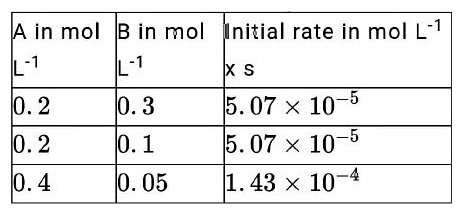Cycloalkenes and alka- dienes are structural isomers and it is observed that the isomerisation reaction of cyclo-butene into 1,3, buta-diene follows 1st order kinetics with respect to cyclobutene. The rate constant of the reaction can be determined by hydrogenting ( reaction with H2 to remove unsaturation) the reaction mixture and different instant and measuring the amount of hydrogen required. In one such experiment two separate glass flasks of volume 1 litres. were added with same amount of cyclobutene and sealed. While one flask was broken after 138.6 min and the contents required 39.2 ml of H2 gas at 1 atm pressure and 273K, where as other flask was broken after a very long time and the contents required 44.8 ml of H2 gas at 1 tam pressure and 273K . From the information given above and given data, anwer the questions that follows:
ΔH∘f Cyclobutene=175kJ/mol
ΔH∘fButa-1,3-diene =125kJ/mol
The rate at which heat is released in isomerisation of cyclobutene at t=69.3 min
A
50kJ
B
5J/min
C
0.25J/min
D
10J/min
Text Solution
The correct Answer is:c
|
Topper's Solved these Questions
Similar Questions
Knowledge Check
Cycloalkenes and alka- dienes are structural isomers and it is observed that the isomerisation reaction of cyclo-butene into 1,3, buta-diene follows 1st order kinetics with respect to cyclobutene. The rate constant of the reaction can be determined by hydrogenting ( reaction with H2 to remove unsaturation) the reaction mixture and different instant and measuring the amount of hydrogen required. In one such experiment two separate glass flasks of volume 1 litres. were added with same amount of cyclobutene and sealed. While one flask was broken after 138.6 min and the contents required 39.2 ml of H2 gas at 1 atm pressure and 273K, where as other flask was broken after a very long time and the contents required 44.8 ml of H2 gas at 1 tam pressure and 273K . From the information given above and given data, anwer the questions that follows:
ΔH∘f Cyclobutene=175kJ/mol
ΔH∘fButa-1,3-diene =125kJ/mol
The average life of cyclobutene will be:A100minB69.3 minC0.01 minD1.386 minCycloalkenes and alka- dienes are structural isomers and it is observed that the isomerisation reaction of cyclo-butene into 1,3, buta-diene follows 1st order kinetics with respect to cyclobutene. The rate constant of the reaction can be determined by hydrogenting ( reaction with H2 to remove unsaturation) the reaction mixture and different instant and measuring the amount of hydrogen required. In one such experiment two separate glass flasks of volume 1 litres. were added with same amount of cyclobutene and sealed. While one flask was broken after 138.6 min and the contents required 39.2 ml of H2 gas at 1 atm pressure and 273K, where as other flask was broken after a very long time and the contents required 44.8 ml of H2 gas at 1 tam pressure and 273K . From the information given above and given data, anwer the questions that follows:
ΔH∘f Cyclobutene=175kJ/mol
ΔH∘fButa-1,3-diene =125kJ/mol
which of the followin cannot be a possible value of volume of hydrogen measured at 1 atm and 300K required if the first bottle is broken at any other tim?A20mlB25mlC29mlD40mlThe activation energy ofr a reaction can be determined by measuring the reaction rate at different:
AtemperatureBcatalyst concentrationsCreactant concentrationsDtimes on the reaction curve.
Addition of bromine to buta-1,3-diene gives:
View SolutionButa-1,3-diene when treated with Br2 gives
View SolutionSelect the correct option for 1st order reaction 2A→product having rate constant of reaction 1.386×10−2min.
View SolutionIn a reaction between A and B, the initial rate of reaction was measured for different initial concentration A and B as:

Find the order of reaction with respect to A and B.
View SolutionObserved heat of hydrogention for cyclohedxa-1,4diene and cyclo hexa-1,3 diene is x& Y kcal /mol respectively , calculate the resonacne energy of cyclohexa-1,3-dine :
View Solution
